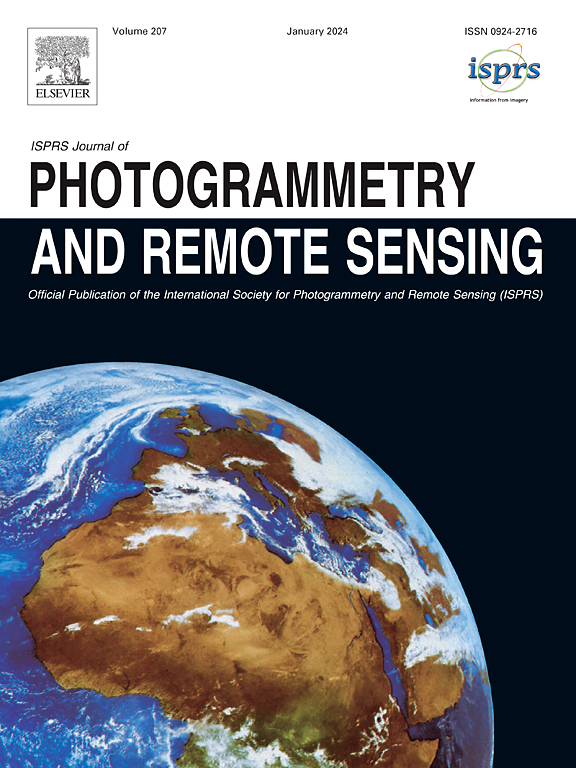Mitigating NDVI saturation in imagery of dense and healthy vegetation
IF 10.6
1区 地球科学
Q1 GEOGRAPHY, PHYSICAL
ISPRS Journal of Photogrammetry and Remote Sensing
Pub Date : 2025-06-18
DOI:10.1016/j.isprsjprs.2025.06.013
引用次数: 0
Abstract
The Normalized Difference Vegetation Index (NDVI) is a widely used tool for assessing vegetation in remote sensing. However, its non-linear response to increasing vegetation vigor, especially in dense and healthy canopies, often leads to inaccurate estimations of vegetation status — a phenomenon known as NDVI saturation. This study investigates the underlying causes of NDVI saturation and proposes a two-stage saturation mechanism. In contrast to the first-stage optical saturation caused by biophysical constraints, we demonstrate that second-stage mathematical saturation can be mitigated through functional optimization. To address this issue, we introduce a new vegetation index (VI), Saturation Mitigated NDVI (NDVIsm), which modifies the NDVI structure by integrating an anti-saturation module. This modification enhances the index’s sensitivity to changes in vegetation vigor dynamics by amplifying variation among high NDVI values, thereby mitigating saturation effects. The performance of NDVIsm was validated across multiple remote sensing platforms and land cover types. NDVIsm eliminated saturation (defined as areas where more than 80% of pixels fall within less than 20% of the index range) and exhibited a more dispersed distribution with a pronounced right tail in the histogram. The effectiveness of NDVIsm in mitigating saturation was further confirmed by improved Pearson correlations (r) with canopy structure (0.3010 increase in Leaf Area Index (LAI) and 0.2452 increase in Leaf Structure Parameters (N)) and vegetation vigor (0.5575 increase in Chlorophyll Content (Cab)), as well as enhanced performance in machine learning (ML)-based yield prediction models when combined with non-optical and spatial features. Overall, NDVIsm demonstrates improved sensitivity in detecting subtle variations in dense and healthy vegetation and offers a promising solution to the saturation problem in environmental remote sensing.
缓解茂密健康植被影像NDVI饱和度
归一化植被指数(NDVI)是一种应用广泛的植被遥感评价工具。然而,其对植被活力增加的非线性响应,特别是在茂密和健康的冠层中,往往导致植被状态的不准确估计-一种称为NDVI饱和度的现象。本研究探讨了NDVI饱和的潜在原因,并提出了两阶段饱和机制。与生物物理限制引起的第一阶段光学饱和相反,我们证明了第二阶段的数学饱和可以通过功能优化来缓解。为了解决这一问题,我们引入了一种新的植被指数(VI),即饱和缓解NDVI (NDVIsm),该指数通过集成抗饱和模块来改变NDVI结构。该修正通过放大NDVI高值间的变化,增强了指数对植被活力动态变化的敏感性,从而缓解了饱和效应。在多个遥感平台和土地覆盖类型上验证了NDVIsm的性能。NDVIsm消除了饱和度(定义为超过80%的像素落在指数范围不到20%的区域),并在直方图中表现出更分散的分布,具有明显的右尾。通过提高与冠层结构的Pearson相关性(r)(叶面积指数(LAI)增加0.3010,叶结构参数(N)增加0.2452)和植被活力(叶绿素含量(Cab)增加0.5575),以及结合非光学和空间特征的基于机器学习(ML)的产量预测模型的性能,进一步证实了NDVIsm缓解饱和的有效性。总体而言,NDVIsm在检测茂密和健康植被的细微变化方面表现出更高的灵敏度,为环境遥感中的饱和问题提供了一个有希望的解决方案。
本文章由计算机程序翻译,如有差异,请以英文原文为准。
求助全文
约1分钟内获得全文
求助全文
来源期刊

ISPRS Journal of Photogrammetry and Remote Sensing
工程技术-成像科学与照相技术
CiteScore
21.00
自引率
6.30%
发文量
273
审稿时长
40 days
期刊介绍:
The ISPRS Journal of Photogrammetry and Remote Sensing (P&RS) serves as the official journal of the International Society for Photogrammetry and Remote Sensing (ISPRS). It acts as a platform for scientists and professionals worldwide who are involved in various disciplines that utilize photogrammetry, remote sensing, spatial information systems, computer vision, and related fields. The journal aims to facilitate communication and dissemination of advancements in these disciplines, while also acting as a comprehensive source of reference and archive.
P&RS endeavors to publish high-quality, peer-reviewed research papers that are preferably original and have not been published before. These papers can cover scientific/research, technological development, or application/practical aspects. Additionally, the journal welcomes papers that are based on presentations from ISPRS meetings, as long as they are considered significant contributions to the aforementioned fields.
In particular, P&RS encourages the submission of papers that are of broad scientific interest, showcase innovative applications (especially in emerging fields), have an interdisciplinary focus, discuss topics that have received limited attention in P&RS or related journals, or explore new directions in scientific or professional realms. It is preferred that theoretical papers include practical applications, while papers focusing on systems and applications should include a theoretical background.
 求助内容:
求助内容: 应助结果提醒方式:
应助结果提醒方式:


